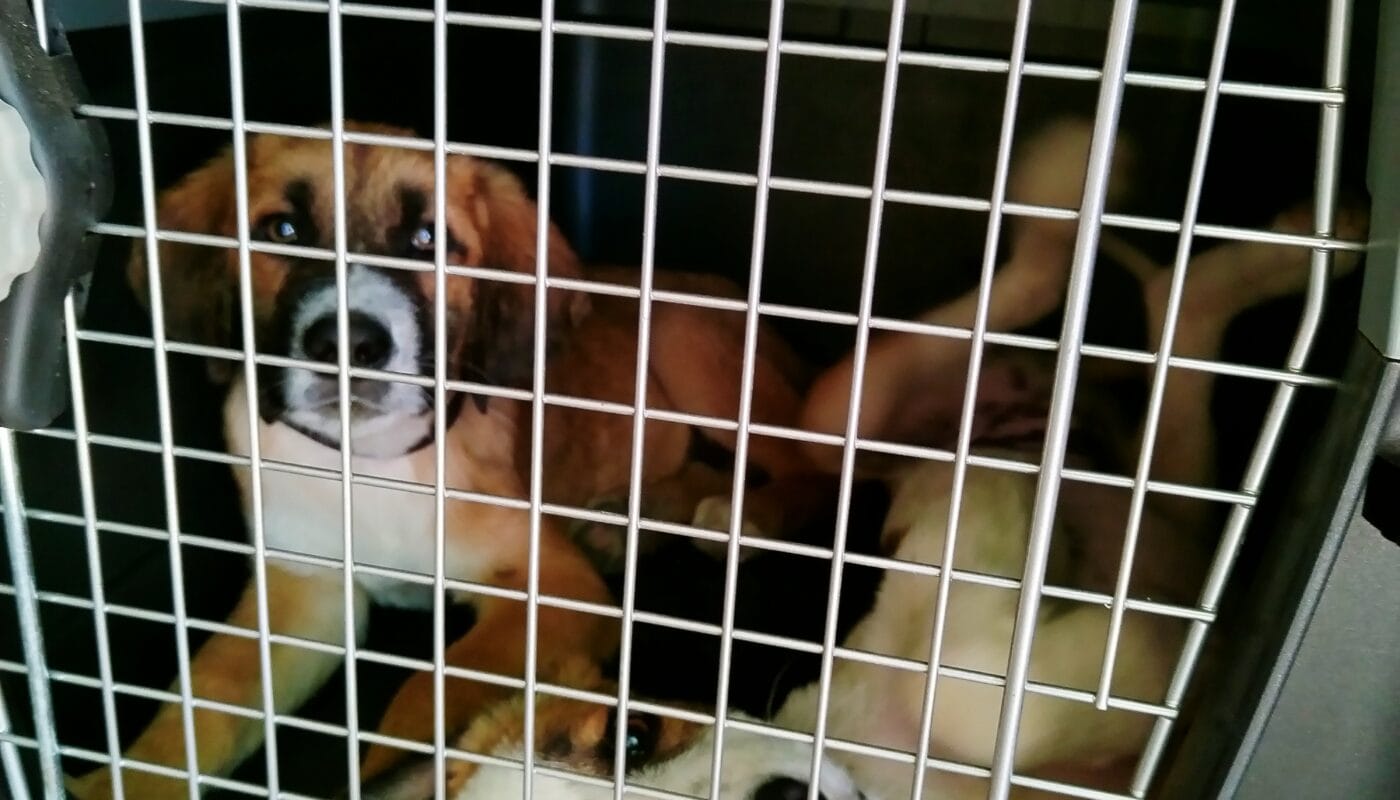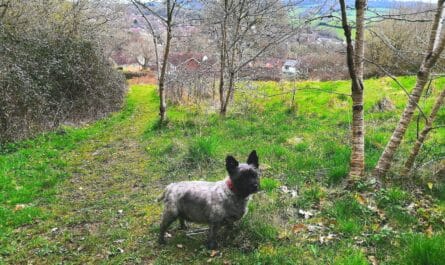If you’ve chosen the right travel crate and accessories, you’re on your way to making road trips with your dog safe and comfortable. However, an essential step that often gets overlooked is crate training your dog for travel.
Crate training helps your dog feel secure in their crate, making it a cosy retreat, not a scary box. This reduces stress for everyone. For short getaways or long road trips, crate-trained dogs travel more safely.
In my experience, each dog approaches travel differently. Charlie, our English Springer Spaniel, loves his crate, while Ellie, our German Shepherd rescue, needed gentle encouragement. Our rescue puppies, Archie and Murphy, are full of energy but have distinct personalities that require different training approaches.
In this guide, I’ll share the steps we took to crate train our dogs for travel, offering practical strategies for your own pup, whether they are seasoned travellers or nervous first-timers.
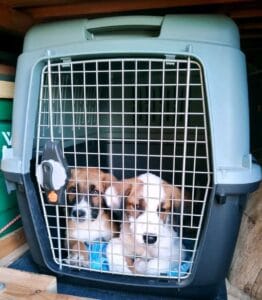
Why Crate Training Your Dog for Travel Matters
Travelling with an untrained dog can be stressful and unsafe. A travel crate provides a safe, familiar space for your dog, making car rides calmer for everyone.
When Crate Training Your Dog, Safety Comes First
A secured Travel crate protects your dog during sudden stops or accidents and keeps them from distracting the driver. After training Ellie, our German Shepherd, to use her travel crate, our car rides became much safer.
A Travel Crate Reduces A Dog’s Anxiety
Many dogs find car rides overwhelming. A travel crate offers comfort and predictability. Charlie, our Springer Spaniel, happily naps in his crate, while Ellie overcame her travel anxiety when she learned her crate was her safe zone.
Get A Head Start with Crate Training Your Puppies
For Archie and Murphy, our puppies, crates transformed stressful car rides into enjoyable experiences. They now eagerly jump in on their own.
Simply put, crate training your dog for travel means more freedom and safer, happier trips for both you and your dog.
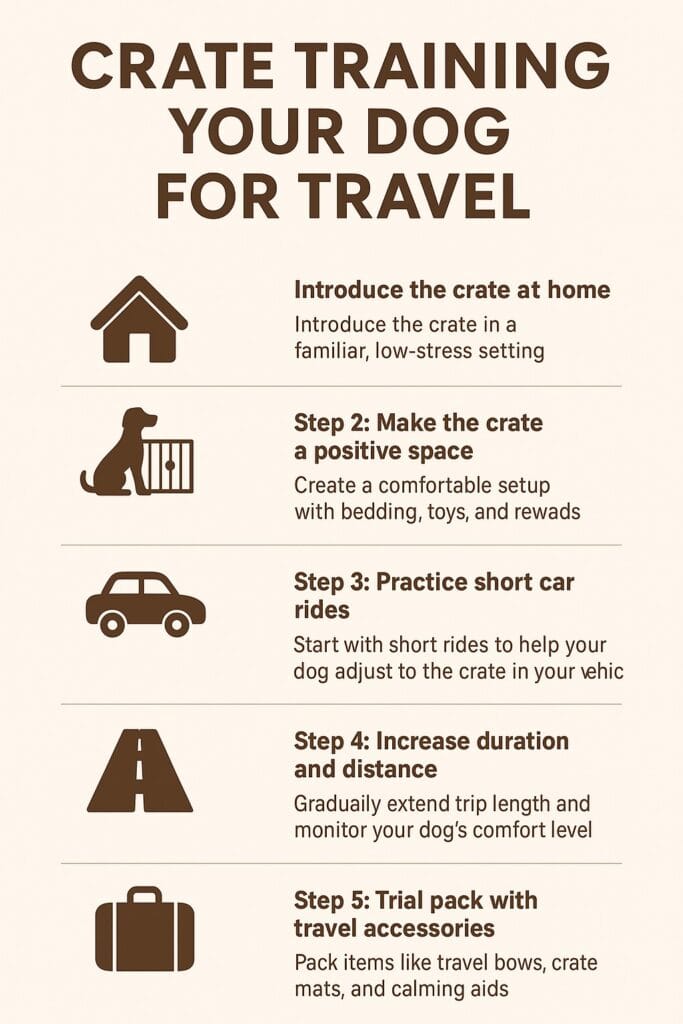
Step 1: Introduce the Travel Crate Training Your Dog at Home
Starting travel crate training your dog at home helps them explore the crate comfortably.
Pick the Right Spot For Your Dog’s Crate
Place the crate in a quiet but social area of your home. Avoid tucking it away in a basement, garage, or spare room. You want your dog to see the crate as a normal, inviting part of their space, not as a place of isolation.
In our open-plan living area, I’ve created a cosy corner for my dogs’ crates. This way, they feel secure but still close to me as I move around the house. It also works perfectly for Archie and Murphy, who are mischievous puppies and need plenty of supervision.
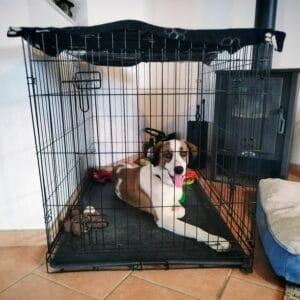
Keep the Crate Door Open
Leave the crate door open to let your dog explore. Make it inviting with a soft blanket, their favourite toy, and treats.
When we set up crates for the puppies, Archie eagerly jumped in, while Murphy cautiously circled before going in for a treat. Every dog explores at their own pace, and both reactions are completely normal.
Use Positive Reinforcement When Crate Training Your Dog For Travel
Successful travel crate training involves rewarding your dog’s curiosity and calmness. Offer treats, praise, or playtime when your dog interacts with the crate.
For instance, Ellie was initially nervous around crates. Rather than forcing her inside, I rewarded her for small steps, like sniffing or putting a paw inside. Gradually, she became more confident and relaxed enough to lie down on her own.
Let Them Set the Pace
Every dog is different. Charlie waltzed into his travel crate the first time like he’d been using it for years. He’s always looking for a Job and thinks it’s a fun game. Whereas Ellie took weeks before she felt safe enough to stay inside her travel crate with the door closed. And that’s okay. Progress matters more than speed.
Stay Consistent When Travel Crate Training Your Dog
Short, regular home crate sessions are more effective than long ones. Gradually increase time spent inside the crate, always ending positively. With Ellie, I praised and rewarded her for entering the travel crate voluntarily, and now she happily sees it as her safe space.
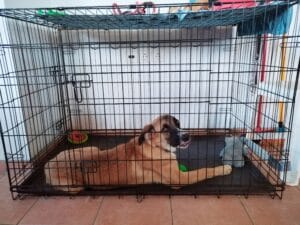
Step 2: Make Travel Crate Training Your Dog A Positive Experience
After your dog feels comfortable exploring their crate at home, help them see it as a spot they enjoy. The aim is for your dog to view the crate as a safe, cosy den where they’ll happily rest, both at home and while travelling.
Create a Comfortable Travel Crate Set-up for Your Dog
Dogs love comfort and consistency. Add soft bedding, a crate mat, or a blanket that smells like home. For older dogs, familiar scents can be especially reassuring.
Ellie, for example, loves curling up on her soft bed. For her, making her travel crate cosy was essential to helping her relax. Our puppies, on the other hand, needed a washable liner because, well… accidents happen when you’re five months old! Having a setup tailored to each dog made a big difference.
Don’t miss my guide for travel crate set-up.
Use Meals and Treats to Build Positive Associations
One of the best ways to create positive feelings about the Travel crate is to feed your dog inside it.
When we first started with Archie and Murphy, I placed their food bowls just inside their crate door. As they grew more confident, I moved the bowls further back. Before long, they were dashing inside at mealtimes, eager to eat.
Now, the sound of kibble hitting their bowls is enough to send both puppies trotting into their crates without hesitation. Feeding time became one of the easiest ways to reinforce that their travel crate is a good place to be.
Incorporate the Crate into Daily Routines
Use the crate for naps and downtime, not just special occasions. This helps your dog see the crate as part of their daily life.
Archie and Murphy, for instance, have nap times after play sessions. By encouraging them to rest in their crates during those times, they quickly learned that the crates are part of their routine. Now, they sometimes wander in on their own when they’re ready to snooze.
Keep Travel Crate Training Your Dog Low-Key
It’s tempting to cheer when your dog finally settles in the crate, but resist the urge to make a big fuss. Instead, keep interactions Low-key. The crate should feel ordinary and safe, not like a dramatic training session.
I’ve noticed that when Charlie chooses his crate on his own, a quiet “good boy” is all he needs. Too much excitement can make some dogs restless again.
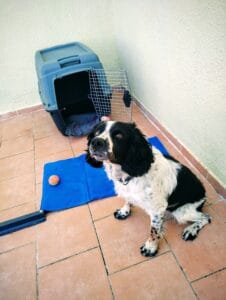
Watch for Stress Signals When Your Dog is In The Travel Crate
Be aware of signs like whining or panting. If your dog is stressed, take a step back and go slower with the training.
For Ellie, slow progress was key. There were days when just resting near the crate was enough. By honouring her pace, we avoided setbacks and built lasting trust.
Pro Tip: Aim for your dog’s travel crate to feel like a private den they want to use, not somewhere they’re made to go.
Step 3: Crate Training Your Dog for Travel in the Car
Once your dog is comfortable in the crate at home, it’s time to introduce their travel crate to the car. Crating in a moving vehicle is different from at home, so be patient.
Start with The Travel Crate in a Parked Car
Place the Travel crate in your car where it will be during trips and let your dog explore it while the vehicle is stationary.
When I introduced the puppies to travel crates to our campervan, I sat nearby while Austin opened and closed the doors, walked around the vehicle, and made little noises with the seatbelts. Archie adjusted quickly and was wagging his tail within minutes. Murphy was more suspicious, but with a few treats tossed inside, he eventually hopped in to investigate.
Secure the Travel Crate in Your Vehicle Properly
A stable travel crate is essential for your dog’s comfort. Secure it with straps or against a solid surface. For Charlie, who’s a confident traveller, this wasn’t a big deal. But for Ellie, who’s sensitive to movement, the extra stability made her feel secure. The difference was immediate. Once her crate felt steady, she settled down more easily.
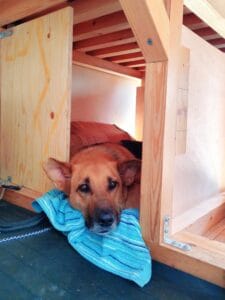
Begin with Very Short Drives
Your first drive should be short and sweet. Even a quick loop around the block is enough to start.
I still remember our puppies’ first trip! Archie stood up the whole time, trying to peek out, while Murphy whined for a minute and then promptly fell asleep. He rolled over with his belly in the air. Their reactions couldn’t have been more different, but both learned quickly that nothing scary happened.
Stay Neutral and Observant
If your dog whines or shifts around, don’t panic. Stay neutral and observant. Dogs pick up on our energy, so if you’re anxious, they’ll be nervous too.
When Austin drives, I often sit near the travel crates to quietly reassure the dogs. A calm “you’re okay” in a steady voice works wonders, especially for Ellie, who looks to us for reassurance.
End You Dog’s Travel Crate Training on a Positive Note
After every ride, reward your dog with praise, a small treat, or something fun like a walk at the park. This helps them view crate time as a fun adventure.
Archie and Murphy now bounce into their travel crates happily when they realise we’re heading to the beach. That positive association didn’t happen overnight, but short, consistent trips made it stick.
Don’t miss my Guide to travelling in a car with your dog
Step 4: Gradually Increase Travel Crate Time In Your Vehicle
Once your dog is comfortable with short car rides in their Travel crate, it’s time to slowly increase the duration. Just like people, dogs need time to adjust to new experiences. Think of this stage as building endurance for longer trips.
Take It One Step at a Time
Jumping from a five-minute ride to a two-hour road trip can overwhelm even confident dogs. Instead, gradually extend rides. Start with 10 minutes, then 20, then 30, and so on.
With Archie and Murphy, we added about 10 minutes each week. Archie seemed to enjoy the change, his nose twitching at every new scent when we cracked the window. Murphy, though, sometimes got restless after 15 minutes. By stretching the rides gradually, he learned to settle down without becoming overwhelmed.
Plan Positive Destinations
Make longer rides rewarding by ending at fun spots. Drive to a local park, trail, or even just a safe town for a short walk.
For Charlie, trips that ended at the beach quickly became his favourite. He learned that crate rides didn’t just mean “waiting time”; they meant swimming, splashing, and stick chasing. Even Ellie, who once dreaded car time, perked up when she realised rides could lead to countryside walks.
Watch for Signs of Stress During the Journey
Look for signs like restlessness, drooling, or whining. These are common signs that your dog may be anxious. If this happens, shorten the ride next time and increase the length more gradually.
Ellie used to pant heavily during car rides, especially if they lasted longer than 20 minutes. By pulling back and sticking to shorter sessions, we avoided overwhelming her and helped her build confidence.
Rest Stops
On long trips, take breaks every 1–2 hours for your dog to go potty, stretch, and hydrate. These breaks help prevent restlessness and reinforce that travel time includes regular relief and comfort.
The puppies love these stops. It’s like a mini adventure in the middle of the bigger adventure. Archie sniffs every blade of grass, while Murphy seems to think every rest stop is a new playground.

Practice Car Rides
Regular practice rides, even short ones, are key. When we skipped training for a few weeks, Ellie regressed and became uneasy again. But once we returned to regular, predictable practice, her progress resumed.
Pro Tip: Treat this step like training for a marathon. Start with short rides and build up gradually, just as you would with running.
Step 5: Build a Travel Routine With Your Dog
Once your dog is calm and comfortable in their Travel crate during rides, the final step is to create a consistent routine around travel. Dogs thrive on predictability. When they know what to expect, they feel more secure.
Establish Pre-Travel Rituals For Your Dog
A pre-travel routine helps signal to your dog that a Travel crate ride is coming. This could include:
- A potty break before loading up
- A drink of water
- Offering a favourite toy or chew in the crate
- A calm “let’s go” cue before heading out
For our pack, potty breaks are non-negotiable before every trip. Charlie is reliable, but Ellie prefers reassurance. She’ll circle and sniff until she feels ready. The puppies, on the other hand, need multiple chances (and sometimes still surprise us). This routine helps prevent accidents and sets the stage for a smooth trip.
Keep Departures Calm
Avoid making a big fuss before leaving. Dogs can pick up on your energy, and if you’re anxious or overly excited, they’ll mirror that. Calm, matter-of-fact departures create a sense of normalcy.
I learned this the hard way with Archie. The first few times, I said things like, “Okay, buddy, are you ready to go on a BIG adventure?” He got so hyped up that he barked nonstop in his travel crate. Now, I keep it simple, just a calm “crate time” cue, and he settles much faster.
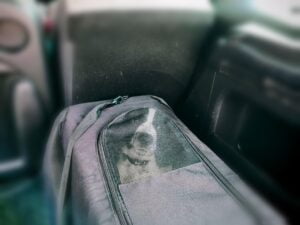
Stick to Familiar Cues When Crate Training Your Dog For Travel
Use the same verbal cues and body language every time. Whether it’s “crate,” “kennel up,” or “let’s go,” consistency builds confidence.
Ellie responds best to a quiet “crate” paired with a hand gesture. The puppies, being eager learners, race into their crates the second they hear the word.
Create a Travel Rhythm During Journeys
On longer road trips, build in breaks for water, bathroom time, and stretching. Dogs quickly recognise the rhythm and relax more between stops.
During a recent 5-hour drive, we stopped every 90 minutes. By the second stop, Charlie and Ellie both anticipated the break and calmly waited instead of pacing. The puppies learned quickly, too, and they now associate stops with fun sniffing opportunities.
Pro Tip: Keeping a calm, predictable routine helps your dog feel comfortable and makes travel easier for you, too.
Step 6: Troubleshooting Common Travel Crate Problems In the Car
Even with careful travel crate training, challenges arise with your dog. The good news? Most issues can be resolved with patience, consistency, and a little creativity.
Problem 1: Whining in the Travel Crate
Whining is one of the most common issues during travel. Dogs may whine from excitement, anxiety, or boredom.
Solutions:
- Wait for quiet before giving attention or letting your dog out.
- Offer a chew or toy to keep them occupied.
- Make sure they’ve had a potty break before leaving.
Ellie whined constantly during her early car rides. It was heartbreaking, but responding every time made it worse. By waiting for even brief moments of silence before rewarding her, she gradually learned that calmness, not whining, earned her attention
Problem 2: Restlessness or Pacing
Some dogs won’t settle easily and may stand or turn circles inside their travel crate.
Solutions:
- Ensure the crate is the right size (big enough to stand and turn, but not too roomy).
- Add a non-slip mat so they feel stable.
- Practice calm crate time at home with distractions.
Murphy was our restless pup. He’d spin like a top for the first 10 minutes of every ride. Once we added a supportive mat and worked on calmness at home, his restlessness eased.
Problem 3: Motion Sickness
Just like humans, dogs can get carsick, especially puppies.
Solutions:
- Avoid feeding large meals right before travel.
- Keep the car cool and well-ventilated.
- Take short practice rides to build tolerance.
- In severe cases, ask your vet about motion sickness medication.
Archie had a few queasy trips early on, leaving us with more than one messy crate cleanup. Feeding him smaller portions before travel solved most of the problem.
Problem 4: Resistance to Entering the Crate
Some dogs baulk at loading up, even if they’re fine once inside.
Solutions:
- Use high-value treats or meals to lure them in.
- Keep your cue consistent (“crate” or “kennel”).
- Make loading calm, routine, and not rushed.
Ellie used to hesitate every single time. By tossing in a piece of chicken and calmly waiting, we turned her travel crate entry into something she looks forward to.
Problem 5: Barking at Stops
Some dogs bark or get overly excited whenever the car stops.
Solutions:
- Ignore barking until your dog is calm.
- Reward quiet moments at stoplights or parking lots.
- Practice short drives with multiple stops to desensitise them.
Archie barked every time we braked for a red light. After weeks of ignoring the noise and rewarding silence, he learned that staying calm worked better.
Remember: patience is your best tool. Every dog progresses at their own pace, and setbacks are part of the journey. What matters most is consistency.
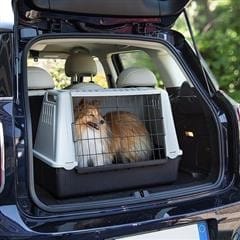
Conclusion: Travel Crate Training is A Journey of Trust and Consistency
Crate training your dog for travel isn’t a quick fix; it’s a process of building trust, calmness, and routine. Each step, from exploring the crate at home to napping peacefully on long drives, builds toward a dog who feels safe and secure wherever the road takes you.
Every dog in our pack has taught me something different:
- Charlie showed me how much dogs love a familiar den once it feels like “theirs.”
- Ellie reminded me that slow, patient progress matters most for anxious dogs.
- Archie proved that puppies can learn quickly when travel feels fun.
- Murphy reminded me that restlessness and setbacks aren’t failures; they’re just part of the process.
Travelling with dogs can be messy, unpredictable, and sometimes challenging, but it’s also one of the most rewarding ways to build a deeper bond. Watching our pack curl up peacefully in their travel crates as the miles roll by is proof that the effort is worth it.
Quick Reference: 7 Steps to Crate Training Your Dog for Travel
- Introduce the Crate at Home
- Let your dog explore freely—no pressure.
- Make the Travel Crate a Positive Experience for Your Dog
- Add bedding, meals, and calm time inside.
- Practice Short Car Rides
- Start small with parked car sessions, then quick loops.
- Gradually Increase Travel Time
- Build up rides slowly, ending at fun destinations.
- Teach Calmness in the Travel Crate
- Reward quiet, relaxed behaviour at home and in the car.
- Build a Travel Routine
- Create predictable pre-trip and on-the-road rituals.
- Troubleshoot Challenges
- Stay patient, adjust for whining, restlessness, or sickness.
Over to you: Are you starting Travel crate training for your next road trip? Or do you already have a seasoned traveller? Share your experiences in the comments—I’d love to hear how it’s going for you!
If you haven’t yet bought a travel crate for your dog, you might like to read my guide about the best crate options for a stress-free journey.


